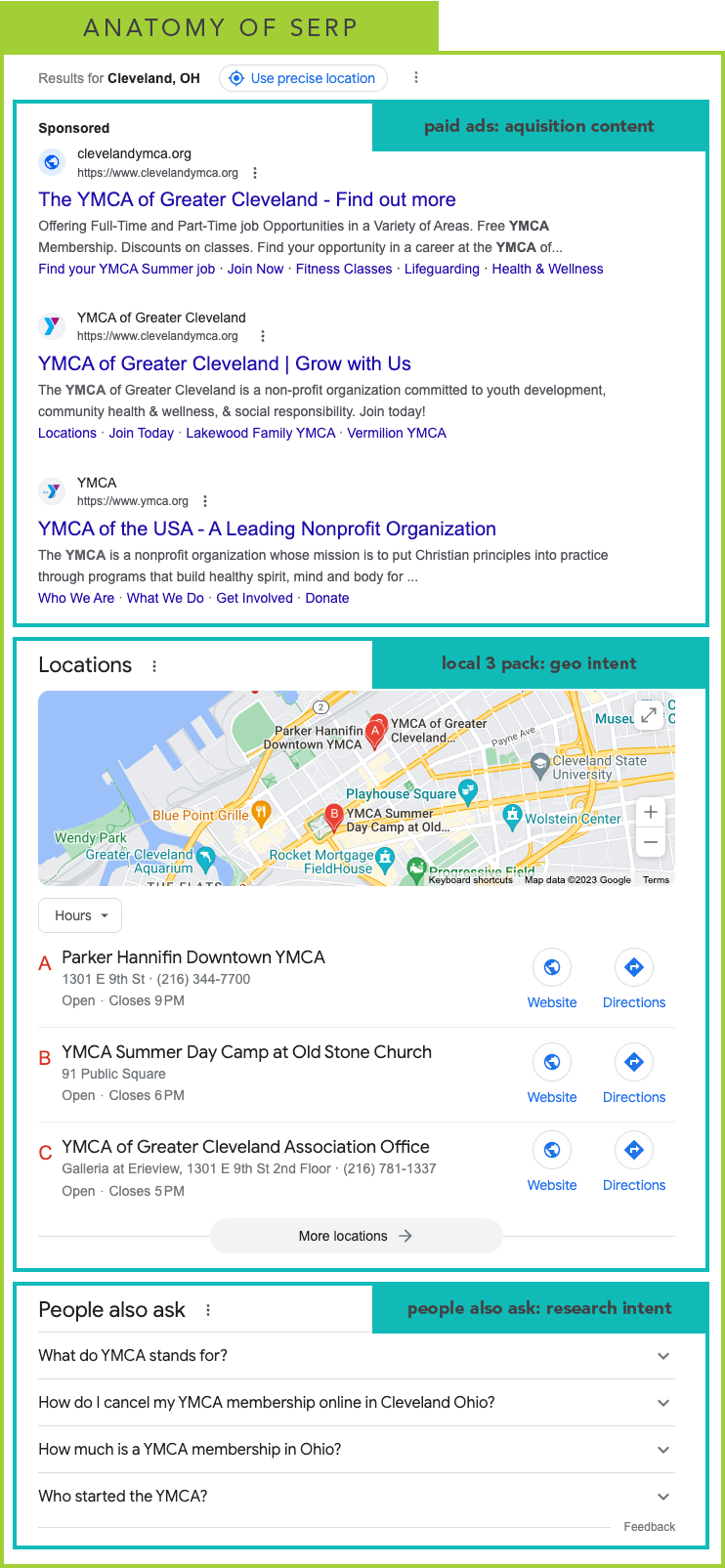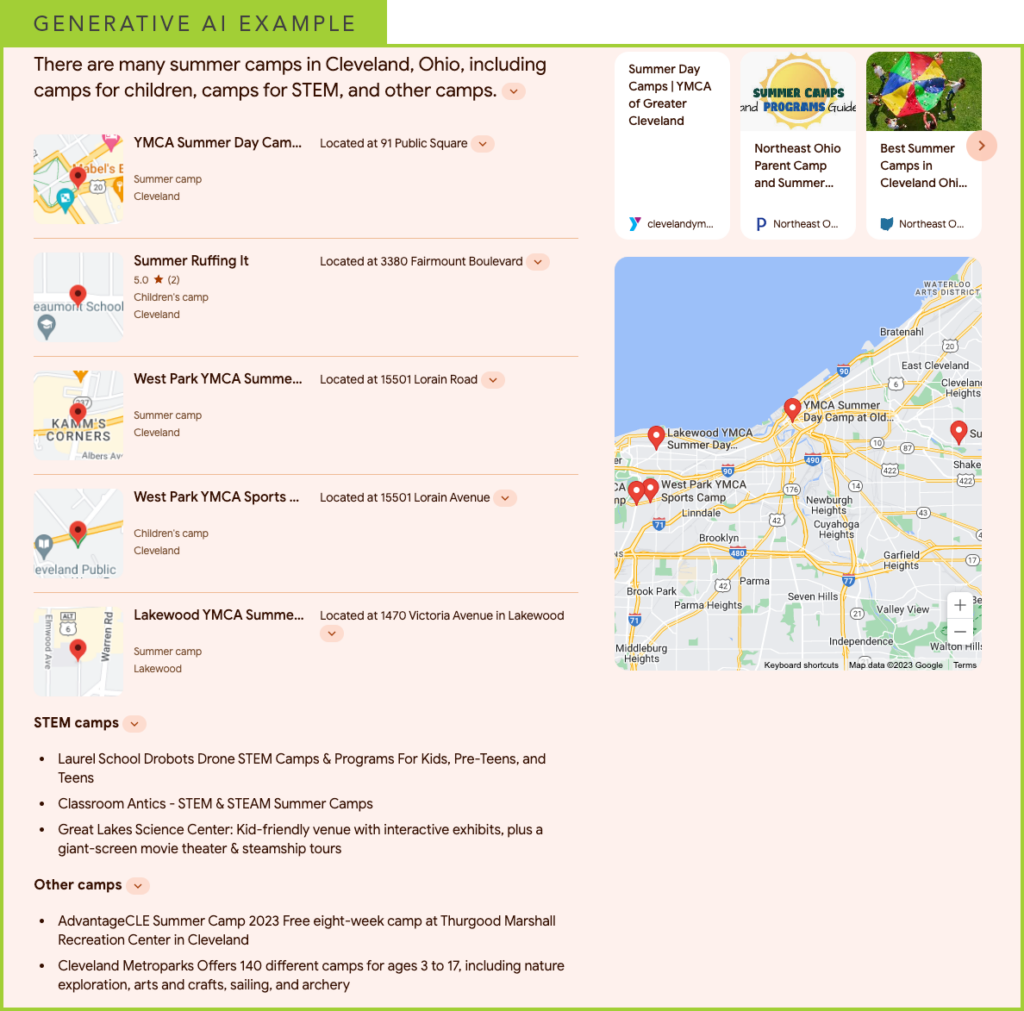Read
Today’s Evolving Search Results Page: A Marketer’s Guide
anatomy of the SERP

Building an SEO Strategy to Capture Search Intent Across the User Journey
In the fast-paced realm of digital marketing, a transformative shift is unfolding on the Search Engine Results Page (SERP), one that has subtly reshaped the way users engage with answers to their queries. What was once a simple list of blue links has morphed into a dynamic visual destination with multifaceted and engaging elements reminiscent of a social media platform.
In the past, the primary function of the SERP was clear cut: it served as a conduit, directing users to external websites. Its objective today extends beyond merely facilitating website traffic; for a growing number of search queries, the aim is to captivate and retain users directly within the confines of the SERP itself.
This shift in the SERP landscape calls for a paradigmatic change in SEO strategy. It necessitates viewing the SERP as more than just a static results page but a dynamic publication in its own right. Within this publication, digital marketers have the opportunity to publish multiple “stories” or content pieces, each meticulously crafted to target a diverse audience with varying search intents.
My team and I have explored the intricacies of today’s SERP, and we’re eager to provide insights into how to effectively capture diverse search intent across the user journey. One thing is certain: the SEO landscape is evolving fast, and success lies in embracing and mastering these new dynamics.
#1: Optimize for the Modern SERP
One of the critical challenges in the modern SERP landscape is catering to an entire spectrum of intent on a single page. A single search result can serve users with various intents, including:
- Featured Snippet: Designed to provide instant answers and keep users on the SERP.
- Traditional Result: Serving as the backbone of SERPs, addressing users seeking information.
- Local Results: Catering to users with navigational and local business intent.
- Knowledge Graph: An often-underutilized section targeting users who want to explore and learn more about a specific topic, person, or brand.
- Multimedia (e.g., Video, Images): Engaging users who prefer visual and interactive content.

Anatomy of a SERP example: This search results page is targeting diverse audiences with multiple intent (e.g., paid ads, local 3-pack, People Also Ask results).
Where one user may want a quick answer, another may wish to research a topic in depth. No single SEO tactic can cover the entire SERP landscape effectively. As a result, siloed optimization for just organic rankings is no longer sufficient. The solution lies in taking a comprehensive SERP-focused approach that combines multiple optimization strategies, from understanding user psychology to:
- Crafting long-form, E-E-A-T-rich content for organic rankings and featured snippets.
- Optimizing site architecture and technical elements for organic performance.
- Building location-optimized Google Business Profiles for local pack visibility.
- Implementing structured data for knowledge panels.
- Creating engaging, high-quality visual assets for multimedia results.
- Analyzing search metrics to understand the blend of intents to target.
By combining these technical and content strategies in a holistic way, modern SEO professionals can effectively address the diverse information needs represented across the full SERP landscape.
#2: Integrate SEO and Paid Search Strategies
Powerful SEO strategies like these don’t have to operate in a silo. Far from being combative, paid search ads and organic SEO pursuits can actually work together in a complementary fashion. When integrated effectively, these two pillars of digital marketing can target users at various stages across the searcher’s journey.
Paid search ads, for instance, are ideal for targeting potential customers in the early acquisition or awareness stages. Thoughtfully crafted text ads can attract relevant users by prominently displaying a brand’s offering within the paid ad sections at the top and bottom of SERPs. Dedicated, conversion-optimized landing pages allow that initial interest to be channeled into lead generation or sales.
Meanwhile, organic SEO enables brands to reach users who are researching and comparing options. Ranking for relevant keywords guides searchers to pages like informative blog posts and FAQs. Optimizing these pages for Featured Snippets can help to position a brand as an authority with quick answers at the top of SERPs.
Rather than competing, paid search and organic SEO strategies can work hand-in-hand across the customer journey. Thoughtful integration, based on understanding searcher motivations and behavior, allows brands to acquire new users through paid ads and nurture continued interest through valuable organic content. At the end of the day, a multi-pronged approach is key to maximizing visibility and conversions on SERPs.
#3: Embrace the Rise of Generative AI
Paid ads aren’t the only ally to SEO on the SERP. The emergence of generative AI models, like ChatGPT, is beginning to reshape the way users interact with search engine results pages. Through Search Generative Experience, Google users can opt to receive an AI-powered overview of their search query, which provides them with a summarized answer paired with multiple cited sources.
With all this at their fingertips, users no longer have to perform multiple searches or click through multiple sites from organic results. For those who do need additional research, AI-generated follow-up questions encourage easy exploration on the SERP. A well-crafted prompt can swiftly gather information that would have previously required numerous queries. Certainly, producing and optimizing high-quality content has never been more important.
 Generative AI result example: Generative AI can produce a highly informative search result, like this one, from a single query. To obtain this level of detail through traditional search, a user would need to perform multiple (and likely frustrating) searches.
Generative AI result example: Generative AI can produce a highly informative search result, like this one, from a single query. To obtain this level of detail through traditional search, a user would need to perform multiple (and likely frustrating) searches.
#4: Build Brand Authority and Trust
As generative experiences become more common in SERPs, how should SEO strategies adapt? Many existing tactics that center on understanding and targeting search intent will continue to be relevant. However, there may be an increased emphasis on brand building and PR strategies as factors that influence whether an AI platform cites or recommends a company as an authoritative source.
Generating reliable, helpful information requires an AI to be familiar with and select reputable websites and brands. Companies that build widespread awareness and trust through content marketing, social media, PR, and branding efforts may see that authority reflected in AI responses. So, while foundational SEO remains crucial, brand visibility and reputation will grow in importance as users increasingly get answers directly from generative AI in the SERP.
Key Takeaways for the Future of the Evolving SERP
The evolving SERP landscape presents exciting opportunities and challenges for modern SEO strategy. While the fundamentals of technical optimization remain important, search marketers must adopt a more dynamic, user-focused approach to drive visibility and engagement across the full spectrum of SERP features.
As you work to optimize your SEO strategy, ensure that you are:
- Employing a blend of content and technical tactics to address diverse search intent on a single results page. No one-size-fits-all solution will suffice.
- Integrating paid search and SEO pursuits to maximize visibility across acquisition and research-driven queries. A multi-channel strategy is a must.
- Building brand authority and trust as generative AI puts reputation in the spotlight for ranking in AI-powered search experiences.
- Maintaining an agile, ever-learning approach to SERP optimization as Google’s AI and interface continues to rapidly evolve.
The path to SEO success in 2023 and beyond lies in embracing this dynamic SERP environment. As Google aims to keep users engaged on the results page itself, search marketers must flexibly adapt strategies to not just rank #1 but publish “stories” tailored to match each intent and journey stage. The SERP is now a multifaceted publication, and SEO its editor.
Interested in learning more about how to understand and grow your organic search presence? Learn how the SEO Quadrant™ can help bring certainty to your SEO strategy.



